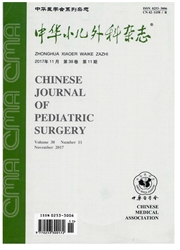

 中文摘要:
中文摘要:
目的 探究沉默分化抑制因子1 (Id1)表达对小鼠骨肉瘤(K7M2-WT)增殖、迁移及凋亡的影响及可能的分子机制,为骨肉瘤的治疗提供新的靶点.方法 实验分3组,空白对照组(Control组),细胞未做任何处理;siRNA组重组腺病毒组(AdsiRNA组),用带表达红色荧光蛋白基因的空载体腺病毒感染细胞;simId1重组腺病毒组(AdsimId1组),特异性针对小鼠Id1基因的小干扰RNA重组腺病毒感染细胞.按分组分别处理K7M2-WT,用RT-PCR、Western bolt检测Id1的mRNA水平及蛋白水平表达,MTT法检测细胞增殖,划痕试验、Transwell检测细胞迁移能力,DAPI染色检测凋亡.结果 AdsimId1感染K7M2-WT 3d能沉默骨肉瘤细胞Id1基因mRNA及蛋白水平的表达.MTT显示Control组、AdsiRNA组和AdsimId1组OD值分别为0.520±0.032、0.490±0.010、0.220±0.006.沉默Id1基因抑制K7M2-WT细胞的增殖,相对Control组及AdsiRNA组抑制率分别为58%和55%(P<O.05).细胞划痕实验结果提示AdsimId1组细胞的迁移较Control组、AdsiRNA组减慢.Transwell实验结果:AdsimId1组的穿膜细胞数为(44.7±3.7)个,显著少于Control组(100.3±3.8)个及AdsiRNA组(103.8±4.4)个(P<0.05).AdsimId1组细胞凋亡较Control组、AdsiRNA组明显.结论 沉默Id1基因使骨肉瘤细胞增殖和迁移能力减弱,增强骨肉瘤细胞的凋亡,为骨肉瘤治疗提供新的靶点.
 英文摘要:
英文摘要:
Objective To explore the effects of siRNA specific for Id1 gene on the proliferation,migration and apoptosis of murine osteosarcoma cell line K7M2-WT and analyze the possible mechanisms so as to seek a new therapeutic target for osteosarcoma.Methods The experiment was divided into three groups of control,blank control and AdsimId1.The murine osteosarcoma cell line K7M2-WT was infected with AdsimId1,AdsiRNA and Adv control respectively.The rnRNA and protein expression of Id1 were detected by reverse transcription-polymerase chain reaction (RT-PCR) and Western blot.Cell proliferation,migration and apoptosis were detected by methylthiazolyl tetrazolium (MTT) assay,wound closure assay (scratch test),Transwell and 4',6-diarmidino-2-phenylindole (DAPI) staining.Results The mRNA and protein expression level of Id1 were downregulated by simId1 at 3 days post-infection.The MTT optical densities (ODs) of control,AdsiRNA and AdsimId1 groups were 0.520 ±0.032,0.490 ± 0.010 and 0.220 ± 0.006 respectively.Compared with control and blank control groups,the inhibition rate of cells in experimental group significantly decreased by 58% and 55%(P〈0.05).Wound healing assay showed that the migratory capacity of K7M2-WT cells decreased with AdsimId1 infection.The number of migratory cells in AdsimId1 group (44.7 ± 3.7) was significantly lower than that of control group (100.3 ± 3.8) or AdsiRNA group (103.8 ± 4.4) (P 〈 0.05).The inhibition of Id1 gene resulted in accelerated apoptosis.Conclusions Silencing of Id1 can effectively inhibit the proliferation and migration ability of murine osteosarcoma cells and promote their apoptosis.Thus Id1 gene may become a new therapeutic target for osteosarcoma.
 同期刊论文项目
同期刊论文项目
 同项目期刊论文
同项目期刊论文
 Azacytidine inhibits the proliferation of human promyelocytic leukemia cells (HL60) by demethylation
Azacytidine inhibits the proliferation of human promyelocytic leukemia cells (HL60) by demethylation A poly(lactide-co-glycolide) film loaded with abundant bone morphogenetic protein-2: A substrate-pro
A poly(lactide-co-glycolide) film loaded with abundant bone morphogenetic protein-2: A substrate-pro 期刊信息
期刊信息
